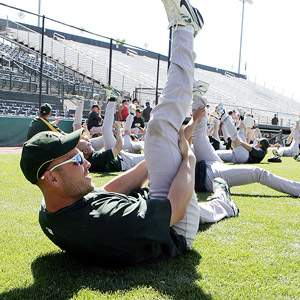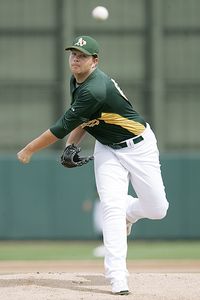Two-day growths are standard, and a good tattoo is always in vogue. "Wedding gown white" remains the coolest uniform color in sports. And from Rollie Fingers to Dennis Eckersley to Travis Buck, the Athletics reign supreme as baseball's Hair Club for Men.
Between the lines, the A's usually find a way to make life interesting, because you never know what high jinks general manager Billy Beane will be up to next.
[+] Enlarge

Take a glance at Oakland's roster, and you'd think that Beane and his Harvard-educated assistant, David Forst, crunched the numbers, did some exhaustive analysis and hatched a novel game plan for success: load up on accomplished, veteran hitters, then complement them with pitchers just in from the senior prom.
But that's an inaccurate assumption. The A's new look is not a case of the Oakland front office zigging while the rest of the industry zagged.
"We had young pitchers in our system and we didn't have a lot of major league-ready position players, so we had to go get them," Forst said. "It's really just sort of a quirky thing."
Oakland's 2009 lineup will be markedly different from the '08 group that ranked last in the American League in runs and last in the majors in OPS. The A's added a first baseman (Jason Giambi) with 396 homers, the 2007 National League MVP runner-up (Matt Holliday), a utility man with a .525 career slugging percentage (Nomar Garciaparra) and a shortstop (Orlando Cabrera) who has averaged 635 at-bats a season since 2006.
The A's took advantage of a slow free-agent market to sign Giambi, Cabrera and Garciaparra for $10.25 million total, and acquired Holliday by trade from Colorado right before his free-agent walk year. Beane will either hang onto Holliday all season and take the draft-pick compensation, or shop him at the trade deadline in July.
Swinging by the Dock of the Bay
![]()
The A's made significant offensive upgrades. Will it be enough for them this season? Check out next-level analysis via ESPN Insider's 30/30 series, previewing every team. 30/30: A's
Beane's course of action will depend largely on how competitive the A's are this season -- which will depend even more on the precocious, talented, untested group of starting pitchers in camp.
The 16 pitchers on Oakland's 40-man roster this spring have made a total of 145 big league starts -- or 52 fewer than Jamie Moyer has logged since his 40th birthday. Dana Eveland leads the way with 35, while Justin Duchscherer and Russ Springer are tied for second with 27.
That's veteran middle reliever Russ Springer, who has scar tissue older than most of the pitchers in Oakland's camp. When Springer made his last big league start with the Philadelphia Phillies in 1996, the team's double-play combination consisted of Kevin Stocker and Mickey Morandini.
Spring Training Blog

Check our daily spring training blog with updates on everything our team of writers and analysts see and hear at the ballpark, plus news tidbits from around the baseball world. Blog
Springer, now 40 years old and entering his 17th and (he claims) final season, arrived in camp and spent a couple of days watching Sean Gallagher, Dallas Braden, Eveland, Gio Gonzalez, Josh Outman and the other young pitchers throw bullpen sessions. Then he went to his peer group -- the Oakland coaches -- and raved about the kids' arms.
"Physically, they're ready," Springer said. "Mentally, it's hard to say. But it surprises me when I ask them how old they are and they tell me '24,' because they don't look like it. The stuff don't look like it, and the body language don't look like it."
The A's, of course, have a track record for cultivating young starters. In 2000, Tim Hudson and Barry Zito put up big numbers while Mark Mulder was taking his lumps two years out of Michigan State. As good as Hudson, Mulder and Zito were, they benefited from slotting in behind veterans Kevin Appier and Gil Heredia, who won a combined 30 games while pitching almost 400 innings nine years ago.
This year, the team's resident veteran and pitching sage is Duchscherer, an All-Star as both a reliever and a starter. That's why it was so disconcerting to see him complain of elbow pain early in spring training. Duchscherer apparently will avoid surgery, but he's expected to begin the season on the disabled list.
The A's didn't think it was worth spending $5 million on Braden Looper or $7 million on Jon Garland, and they took a pass on a twilight tour for Pedro Martinez. Instead, they brought former Diamondbacks swingman Edgar Gonzalez and erstwhile Giants prospect Jerome Williams to camp on minor league invites.
By acclamation, the youngest pitchers in Phoenix provide the greatest reason for excitement. Lefty Brett Anderson, acquired from Arizona in the Dan Haren trade, is rated the seventh-best prospect in the game by Baseball America, while Trevor Cahill, Oakland's second-round pick in 2006, checks in at No. 11. They were teammates in the Futures Game and the Olympics last year, then took a vacation together in Cabo San Lucas in December.
Anderson's father, Frank, has spent the past two decades coaching baseball at Texas Tech, Texas and Oklahoma State, and young Brett has been around the ballfield since he was a toddler. One of his biggest influences was former Longhorns and A's closer Huston Street, who taught him the importance of a strong work ethic and attention to detail.
[+] Enlarge

Scouts in Arizona love Anderson's four-pitch repertoire, mound presence and penchant for working quickly. And Indians outfielder Grady Sizemore made a mental note earlier this week when he led off a game in Phoenix and Anderson broke his bat with a fastball.
Most impressive, Anderson is self-aware enough, at age 21, to realize that each step up the developmental ladder requires an enhanced level of dedication and commitment.
"My biggest thing was getting in shape," Anderson said. "In high school, I could throw my slider and my fastball at 88-91 [mph] and get 90 percent of the people out without trying too hard. I know people don't want to hear this word, but I got a little complacent. But I kept hearing that it wouldn't be the same in Double-A or Triple-A."
Anderson's response? He worked out with the strength and conditioning coach at Oklahoma State, lost some weight, and now his fastball touches 94 mph on the radar gun.
Anderson, Cahill and New Jersey native Vin Mazzaro, who dominated Texas League hitters last year at age 21, are the future of the Oakland organization. How quickly they progress will hinge on how readily they adapt and deal with failure.
"There's a bit of a learning curve," Duchscherer said. "My first time in the big leagues, I got raked. Ultimately, it comes down to the question, how smart are they? How good are their baseball instincts, and how quickly can they make adjustments? Everybody in this room has the physical ability to compete at this level. The mental side makes the difference between an average player and a good player."
The Athletics should score enough runs this year to take some pressure off the pitching staff. But the young pitchers are still going to require some nurturing.
Giambi already has conferred with pitching coach Curt Young to learn the strengths, weaknesses and individual quirks of Oakland's starters. If he sees somebody rushing or getting out of whack mechanically, he won't hesitate to pay a mound visit to dispense a few reminders.
"They look young, but they don't act young, which is huge," Giambi said. "They have a pretty special makeup. They're just out there like it's Legion ball, having a good time."
Thus far, it's been a mutually beneficial relationship. After seven years in staid, uptight New York, Giambi is back in his element as the fun-loving fraternity rush chairman in Oakland. With a little luck, the kids might repay him for his kindness by providing some welcome flashbacks to the Hudson-Mulder-Zito days.
Puel - Barca are world’s best
Real Madrid Register Lassana Diarra For Champions League
Bobby Crosby loses starting role with Oakland Athletics new arrivals